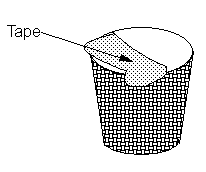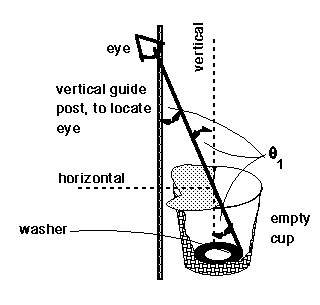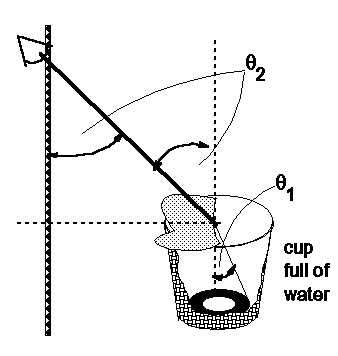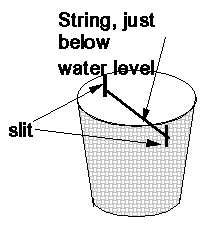Experiment of The Month
Water Refraction
The MU Physics Department does not claim to have invented these labs. Actually, the origin of these labs is currently unknown to us. Our labs do not have written instructions. In keeping with this spirit, the description given here will be brief and general. The intent is that each performance of the lab will be unique; in each nature will reveal a slightly different face to the observer.
We measure refraction of light by water in several ways in our introductory optics laboratories.
The example described here is of interest because it clearly demonstrates the bending of light, and because a student recently made an interesting improvement in the method. We begin with a Styrofoam or cardboard coffee cup and a galvanized 1 3/4" washer, which fits nicely in the bottom of the cup. We put a piece of masking tape across the top of the cup, so that its edge lies approximately along a diameter of the top of the cup, as shown in the figure. We set up a vertical pole on the edge of our lab bench. All observations are made with the observer's head resting against this pole, so that the observing eye stays in the same place for each sighting.
The washer is placed in the bottom of the cup, and the cup is moved away from the observer's eye until the eye sees just the edge of the washer, looking over the edge of the tape. The ray which passes from the edge of the washer, just past the edge of the tape, into the eye, is shown in the cut-away figure at the right. This ray makes an angle "theta 1" with the vertical, as sketched. If the vertical distance from eye to the height of the top of the cup, and the horizontal distance from the pole to the edge of the tape are measured, the angle can be calculated.
Water is added to the cup, filling it to the top, just below the masking tape. Because the light is refracted it is possible to push the cup farther away and still see the washer. It is important at this step to keep the eye located at the vertical pole. In the figure at the right, the ray which leaves the edge of the washer, and passes over the edge of the tape is the same as before. However, upon leaving the water, the ray is now bent away from the normal as shown. The new angle, "theta 2," can be determined (as the first angle was) from measurements of eye height above cup top, and distance from pole to tape edge. Knowing these angles, of course, the index of refraction of water may be calculated.
We have always had the following problem: The water "sloshes" around and wets the tape. Surface tension causes it to form a significant meniscus with the tape, and the image of the edge of the washer is distorted. A physics 232 student, Jeff Roberts, solved this problem for us this semester: He took a piece of thread and fitted it into two slits in the cup sides. The slits are narrow enough that the water does not leak out. The thread replaces the masking tape, sitting slightly under the water, so there is no meniscus. It seems likely that for instructional purposes it will be best to start with the masking tape, which obscures the view of the washer, at first. This will make the point that the light bends. Then when an accurate estimate of the index of refraction is desired, the thread can be added as a refinement.



